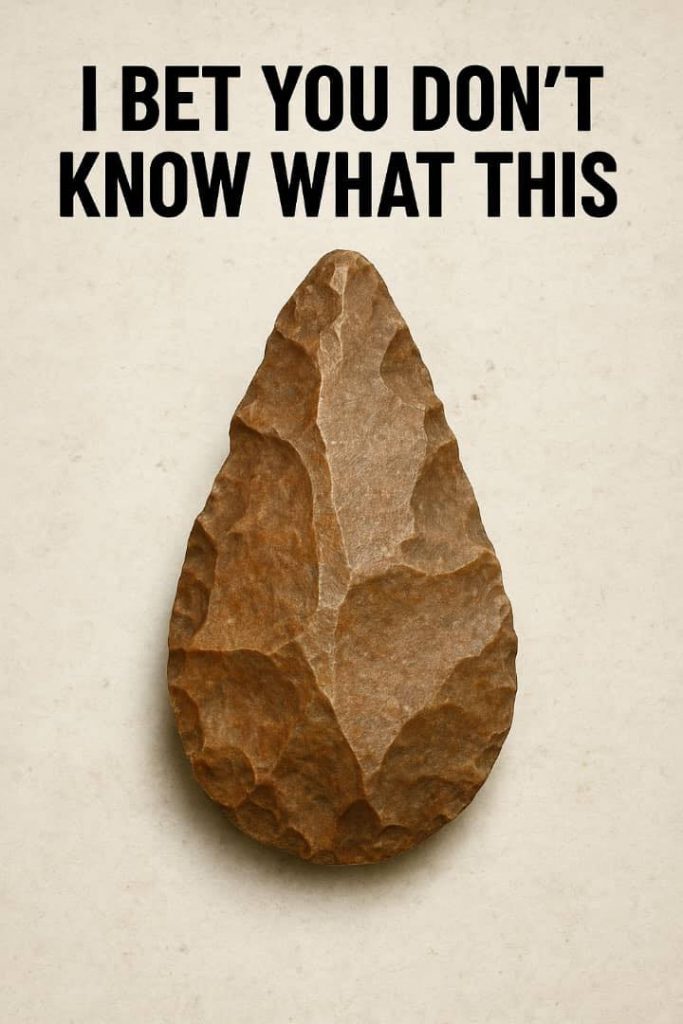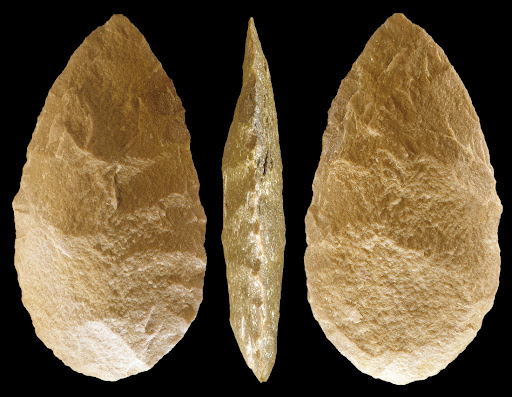The Stone That Changed Everything: Humanity’s First Tool
Most people might walk past it, assuming it’s just an oddly shaped rock. But this simple-looking object carries the story of humanity’s first spark of intelligence — the moment when survival met innovation. What you’re looking at isn’t just a stone. It’s a hand axe, one of the earliest tools ever made by our ancient ancestors more than a million years ago.
A Glimpse Into the Dawn of Human Ingenuity
Long before cities, fire, or even language, early humans were already shaping their world — quite literally. The hand axe, crafted by species like Homo erectus and Homo habilis, marked a turning point in human evolution. It was the first sign that our ancestors could think ahead, plan, and create something with purpose.

Each tool began as a rough piece of flint or basalt. With patient, deliberate strikes, early humans chipped away at the stone, creating razor-sharp edges and a pointed tip. This wasn’t random — it was innovation. The teardrop design made it comfortable to hold, efficient to use, and adaptable for countless tasks.
The Many Uses of the Hand Axe
Think of it as the prehistoric Swiss Army knife. The hand axe wasn’t just a weapon — it was a multipurpose survival tool. It helped ancient humans cut wood, butcher animals, skin hides, and even dig for roots. It was durable, reliable, and easy to carry — an essential companion in the harsh, unpredictable world of the Stone Age.
Every strike, every chip, and every polished surface tells a story of resourcefulness. Imagine standing beside a riverbank a million years ago, shaping your first tool from stone — knowing that this creation could change how you hunt, build, and live. That was the power of the hand axe.
A Tool That Defined an Era
Archaeologists call this period the Paleolithic Age, or the Old Stone Age — a time stretching from roughly 1.7 million to 100,000 years ago. It’s during this era that the hand axe became humanity’s signature invention.
Video : Stone Age Hand Axe Shaped by Complex Brain
Across Africa, Europe, and Asia, countless hand axes have been discovered — some almost identical despite being thousands of miles apart. That uniformity is stunning. It suggests that ancient humans shared knowledge across generations and regions, proving that communication, imitation, and teaching were already part of our DNA.
The hand axe wasn’t just a tool — it was the beginning of human culture.
The Symbol of Human Intelligence
When scientists study a hand axe today, they don’t just see stone. They see imagination. They see problem-solving. They see intention.
Before this invention, animals used found objects — sticks, rocks, bones — to survive. But creating a tool from scratch? That was something entirely new. It was the first time a living being looked at raw material and saw possibility.
The symmetry of many hand axes, their carefully balanced forms, shows an appreciation for design — not just function. In a way, these early tools were also early art.
How One Tool Changed Our Destiny
With the hand axe, humanity took its first step toward mastery of the environment. It made hunting more efficient, which led to better nutrition, stronger bodies, and more time for exploration. That, in turn, encouraged migration — the spread of early humans across continents.

This simple tool, shaped by bare hands and sharp minds, became the foundation for everything that came after: hammers, knives, chisels, and eventually, the technology you’re using to read this right now.
Think about that for a moment — the leap from shaping a stone to shaping a microchip. Both acts come from the same drive: curiosity, creativity, and the desire to make life better.
Unearthing Our Shared Past
Every time archaeologists uncover a hand axe, it’s like finding a message from the deep past. These tools have been discovered in riverbeds, caves, and ancient campsites — each one offering clues about how our ancestors lived, worked, and thought.
Some are rough and crude, showing the early stages of experimentation. Others are beautifully crafted, with smooth edges and near-perfect symmetry. The progression tells us that humanity didn’t just evolve biologically — we evolved mentally and emotionally.
These tools are silent witnesses to our growth as a species — proof that intelligence and creativity have always been at the heart of what makes us human.
Video : How to recognize ancient civilization primitive stone hand axes
A Legacy Carved in Stone
Today, the hand axe stands as a powerful symbol of where we came from. It reminds us that even the most advanced civilizations began with a single idea — that we could shape the world around us.
That teardrop-shaped stone, simple yet sophisticated, was the key that unlocked humanity’s future. It represents more than survival; it represents imagination, progress, and the timeless human spirit of invention.
So, the next time you see a rock like this, take a moment to look closer. You’re not just looking at a piece of stone — you’re looking at the first chapter of our story.
Because long before we built cities or crossed oceans, we learned how to shape a dream — one strike at a time.